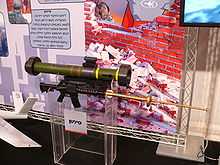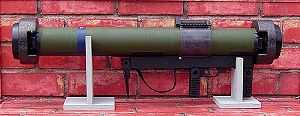MATADOR
| MATADOR (Man-portable Anti-Tank Anti-DOoR) | |
|---|---|
|
The MATADOR (Man-portable Anti-Tank, Anti-DOoR) Short Range Anti-Armour Weapon. | |
| Type | Anti-armor |
| Place of origin | Singapore / Israel / Germany |
| Service history | |
| In service | 2000–present |
| Used by | See Users |
| Wars | Gaza War |
| Production history | |
| Designer |
Singapore Armed Forces, Rafael Advanced Defense Systems, Defence Science and Technology Agency |
| Designed | 1999 |
| Manufacturer | Dynamit Nobel Defence |
| Specifications | |
| Weight | 8.9 kg (19 lb 10 oz) |
| Length | 1 m (3 ft 3 in) |
|
| |
| Caliber | 90 mm (3.5 in) |
| Muzzle velocity | 250 m/s (820 ft/s) |
| Effective firing range | 500 m (1,600 ft) |
| Feed system | Disposable |
| Sights |
Integral optical sights |
MATADOR (Man-portable Anti-Tank, Anti-DOoR) is a 90-millimetre (3.5 in) man-portable, disposable anti-armor weapon system developed in collaboration between Singapore and Israel. It is an updated version of the German Armbrust design, and operates on the same principles. The development of this weapon began in 2000 and the MATADOR will eventually replace the German-Singaporean Armbrust Light Anti-tank Weapon, which has been in service since the 1980s.[1]
The MATADOR was developed jointly by the Singapore Armed Forces (SAF) and the Defence Science and Technology Agency (DSTA), in collaboration with Rafael Advanced Defense Systems[2][3] and Dynamit Nobel Defence (DND) joint team.[1]
Capabilities
The MATADOR is among the lightest in its class. The warhead is effective against both vehicle armour and brick walls. The weapon has little backblast, making it safe for operation in confined spaces.[1]
The MATADOR is supposed to be capable of defeating the armour of most known armoured personnel carriers and light tanks in the world. The dual-capability warhead, when acting in the delay mode, creates an opening greater than 450 mm (18 in) in diameter in a double brick wall, and acts as an anti-personnel weapon against those behind the wall, offering an unconventional means of entry when fighting in built-up areas.[1]
The MATADOR's projectile is claimed to be insensitive to wind due to its propulsion system, which results in a highly accurate weapon system.[1]
Warhead
The warhead can be used in both High Explosive Anti-Tank (HEAT) and High Explosive Squash Head (HESH) modes against armor and walls or other fortifications respectively.[1] Selection is done by extending a "probe" (most likely a fuse extender) for HEAT mode and leaving the "probe" retracted for HESH mode.
Countermass system
Similar to the Armbrust, the countermass counteracts the recoil of the weapon on firing. The countermass consists of shredded plastic, which is projected out of the rear of the weapon when it is fired. This plastic is rapidly slowed by air resistance, allowing the weapon to be fired safely within an enclosed space. In addition, the positioning of the countermass takes into consideration the centre of gravity of the weapon to ensure good balance for greater accuracy.[4]
Variants
.jpg)
Further variants of MATADOR have also been developed by Rafael and Dynamit Nobel, designed primarily for anti-structure use by soldiers operating in dense urban environments.
- MATADOR-MP
- Multi-purpose weapon with a warhead effective against a wide variety of ground targets, from light armoured vehicles to fortified positions and urban walls. As with the initial MATADOR, this is achieved with a dual-mode fuse, which has been improved on the MATADOR-MP such that it now automatically discriminates between hard and soft targets rather than requiring the operator to manually make the selection. A dedicated targeting device, mounted on its Picatinny rail, incorporates a reflex sight and laser rangefinder to provide a high hit probability.[2]
- MATADOR-WB
- Specialised wall-breaching weapon, featuring an Explosively-Formed Ring (EFR) warhead that breaches a man-sized hole, between 75 cm (30 in) to 100 cm (39 in) across, in typical urban walls.[5]
- MATADOR-AS
- Anti-structure weapon with an advanced tandem warhead that can also be set between two modes. The anti-emplacement mode uses an enhanced blast effect to defeat structures and fortifications, while the penetrating/mouse-holing mode defeats light armoured vehicles and creates mouseholes in urban walls.[3] MATADOR-AS has been ordered by the British Army, and is slated for service entry in 2009.[6]
Combat history

The MATADOR saw its first combat deployment in January 2009, by Israeli Defence Force soldiers during Operation Cast Lead in the Gaza Strip. MATADOR-WB in particular was used to breach walls in structures, allowing IDF troops to pass through and attack opponents inside.[7]
Users
 Israel: Israel Defense Forces.[8][9]
Israel: Israel Defense Forces.[8][9] Singapore: Replacing the Armbrust in the Singapore Armed Forces.[10]
Singapore: Replacing the Armbrust in the Singapore Armed Forces.[10] Slovenia: Slovenian Ground Force, locally designated as RGW 90.[11][12]
Slovenia: Slovenian Ground Force, locally designated as RGW 90.[11][12] United Kingdom: British Army has ordered the new Anti-Structures Munition (ASM) version of the MATADOR from Dynamit Nobel Defence.[6]
United Kingdom: British Army has ordered the new Anti-Structures Munition (ASM) version of the MATADOR from Dynamit Nobel Defence.[6] Germany: The German Army has ordered 1,000 MATADOR-AS under the name RGW90 AS with scalable anti-structure munition.[13]
Germany: The German Army has ordered 1,000 MATADOR-AS under the name RGW90 AS with scalable anti-structure munition.[13] Vietnam: Used by the Vietnam People's Army marine force.[14]
Vietnam: Used by the Vietnam People's Army marine force.[14]
See also
References
- ↑ 1.0 1.1 1.2 1.3 1.4 1.5 "Factsheet - MATADOR: Unguided Short Range Anti-Armour Weapon (SRAAW)" (Press release). Singaporean Ministry of Defence (MINDEF). 15 June 2005. Retrieved 16 June 2011.
- ↑ 2.0 2.1 "Rafael Advanced Defense Systems Ltd". Rafael.co.il. Retrieved 2012-11-18.
- ↑ 3.0 3.1 "Rafael Advanced Defense Systems Ltd". Rafael.co.il. Retrieved 2012-11-18.
- ↑ "DSTA Press Release". Safra Radio. Retrieved 2012-11-18.
- ↑ "Matador Brochure" (PDF). Rafael.co.il. Retrieved 2012-11-18.
- ↑ 6.0 6.1 "Dynamit Nobel selected in February 2006 to develop, supply and support the ASM". Armada International, Dated: 1 Aug 2007.
- ↑ "Wall-Breaching Weapon Debuts". Defense Technology International, Dated: 1 Feb 2009.
- ↑ "Israel unleashed Bulls and Matadors on Gaza". Aviation Week. February 23, 2009. Retrieved 2010-06-25.
- ↑ "Breaching walls: a must in mout operations: why breach walls during a military operation? At least two answers immediately come to mind; (1) to neutralise enemy troops that are hiding in the building and (2) to open an access for one's own troops, avoiding too-obvious accesses that would quite certainly be booby-trapped. Those two aspects require two different approaches, however. - Free Online Library". Thefreelibrary.com. 2009-10-01. Retrieved 2012-11-18.
- ↑ "MATADOR - Unguided Short Range Anti-Armour Weapon - Home". Mindef.gov.sg. Retrieved 2012-11-18.
- ↑ "Powered by Google Docs" (PDF). Docs.google.com. Retrieved 2012-11-18.
- ↑ "Slovenian combat units start training with RGW-90s - Jane's Missiles and Rockets". Articles.janes.com. 2008-07-02. Retrieved 2012-11-18.
- ↑ "Die neue Waffe für den Haus-Gebrauch". Augen geradeaus. Retrieved 2012-11-18.
- ↑ New weapons of Vietnam Army (by Vietnamese)
External links
| Wikimedia Commons has media related to MATADOR. |
- Video link
| ||||||||||||||||||||||||||
| ||||||||||||||||||||||||||||||||
